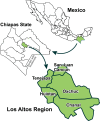The elimination of trachoma as a public health problem in Mexico: From national health priority to national success story
- PMID: 36037211
- PMCID: PMC9462675
- DOI: 10.1371/journal.pntd.0010660
The elimination of trachoma as a public health problem in Mexico: From national health priority to national success story
Abstract
Introduction: Mexico was the first country in the Americas and the third in the world to eliminate trachoma as a public health problem, as validated by the WHO in 2017.
Objective: To describe the critical elements that favored the elimination of trachoma as a public health problem in Mexico and the public health impact of this success.
Methodology: A revision and compilation of data and information contained in the dossier presented by the country to PAHO/WHO to obtain the validation of trachoma elimination as a public health problem was conducted by a group of delegates from the national and local trachoma prevention and control program. Data from the national and local surveillance systems and reports of actions conducted after achieving the elimination goal were also included. Critical elements that favored the achievement of the elimination goal from 1896 to 2019 were extracted.
Results: Mexico reached the elimination of trachoma in 2016 obtaining the validation in 2017. 264 communities were no longer endemic and 151,744 people were no longer at risk of visual impairment or possible blindness due to trachoma. The key to the success of this elimination process was primarily the local leadership of health authorities with sustained funding for brigades, increased access to potable water and sanitation, and key alliances with indigenous authorities, health authorities, and government institutions that contributed to the achievement of the goal. The SAFE strategy started implementation in Mexico in 2004 as a comprehensive package of interventions. SAFE stands for surgery, antibiotics, facial cleanliness, and improvement of the environmental conditions. These actions impacted drastically on the number of new cases trachmatous trichiasis (TT) and trachomatous inflammation-follicular (TF), which decreased from 1,794 in 2004 to zero in 2016.
Conclusions: The elimination of trachoma as a public health problem in Mexico is a true success story that may serve as a model example for the elimination of other neglected infectious diseases in the Americas.
Conflict of interest statement
The authors have declared that no competing interests exist.
Figures




Similar articles
-
The elimination of trachoma as a public health problem in Togo: Successes and challenges.PLoS Negl Trop Dis. 2023 Jul 18;17(7):e0011444. doi: 10.1371/journal.pntd.0011444. eCollection 2023 Jul. PLoS Negl Trop Dis. 2023. PMID: 37463175 Free PMC article.
-
Population-based prevalence survey of follicular trachoma and trachomatous trichiasis in the Casamance region of Senegal.BMC Public Health. 2017 Jul 26;18(1):62. doi: 10.1186/s12889-017-4605-0. BMC Public Health. 2017. PMID: 28747198 Free PMC article.
-
The Gambia has eliminated trachoma as a public health problem: Challenges and successes.PLoS Negl Trop Dis. 2022 Mar 28;16(3):e0010282. doi: 10.1371/journal.pntd.0010282. eCollection 2022 Mar. PLoS Negl Trop Dis. 2022. PMID: 35344553 Free PMC article.
-
The costs of monitoring trachoma elimination: Impact, surveillance, and trachomatous trichiasis (TT)-only surveys.PLoS Negl Trop Dis. 2019 Sep 5;13(9):e0007605. doi: 10.1371/journal.pntd.0007605. eCollection 2019 Sep. PLoS Negl Trop Dis. 2019. PMID: 31487281 Free PMC article. Review.
-
Community-level trachoma ecological associations and the use of geospatial analysis methods: A systematic review.PLoS Negl Trop Dis. 2022 Apr 8;16(4):e0010272. doi: 10.1371/journal.pntd.0010272. eCollection 2022 Apr. PLoS Negl Trop Dis. 2022. PMID: 35395003 Free PMC article.
Cited by
-
The elimination of trachoma as a public health problem in Togo: Successes and challenges.PLoS Negl Trop Dis. 2023 Jul 18;17(7):e0011444. doi: 10.1371/journal.pntd.0011444. eCollection 2023 Jul. PLoS Negl Trop Dis. 2023. PMID: 37463175 Free PMC article.
-
Indigenous Eye Health in the Americas: The Burden of Vision Impairment and Ocular Diseases.Int J Environ Res Public Health. 2023 Feb 21;20(5):3820. doi: 10.3390/ijerph20053820. Int J Environ Res Public Health. 2023. PMID: 36900846 Free PMC article.
References
-
- WHO. Report of the 4th Global Scientific meeting on trachoma. 27–29 November 2018. Geneva: World Health Organization; 2019. (WHO/CDC/NTD/PCT/2019.03). https://apps.who.int/iris/bitstream/handle/10665/325121/WHO-CDS-NTD-PCT-...
-
- Baneke A. Targeting trachoma: Strategies to reduce the leading infectious causes of blindness. Travel Med. Inf. Dis. 2012; 10:92–96. https://www.sciencedirect.com/science/article/abs/pii/S1477893912000063?... - PubMed
-
- Ngondi J, Gebre T, Shargie EB, Graves PM, Ejigsemahu Y, Teferi T, et al.. Risk factors for active trachoma in children and trichiasis in adults: a household survey in Amhara Regional State, Ethiopia. Trans R Soc Trop Med Hyg. 2008. May 1;102(5):432–8. https://academic.oup.com/trstmh/article-abstract/102/5/432/1921202?redir... doi: 10.1016/j.trstmh.2008.02.014 - DOI - PubMed
-
- Mpyet C, Lass BD, Yahaya HB, Solomon AW. Prevalence of and Risk Factors for Trachoma in Kano State, Nigeria. PLOS ONE. 2012. Jul 6;7(7):e40421. https://www.ncbi.nlm.nih.gov/pmc/articles/PMC3391244/ doi: 10.1371/journal.pone.0040421 - DOI - PMC - PubMed
-
- Emerson PM, Lindsay SW, Alexander N, Bah M, Dibba S-M, Faal HB, et al.. Role of flies and provision of latrines in trachoma control: cluster-randomised controlled trial. The Lancet. 2004. Apr 3;363(9415):1093–8. https://www.thelancet.com/journals/lancet/article/PIIS0140-6736(04)15891... doi: 10.1016/S0140-6736(04)15891-1 - DOI - PubMed
MeSH terms
LinkOut - more resources
Full Text Sources
Medical
Miscellaneous

